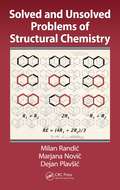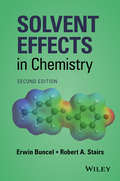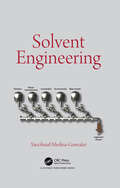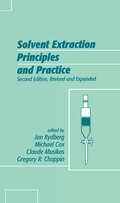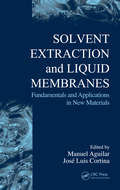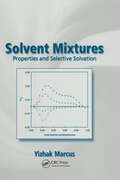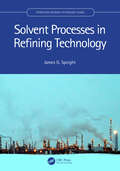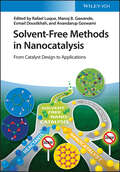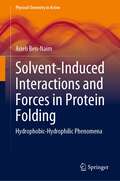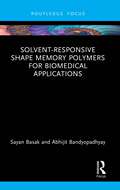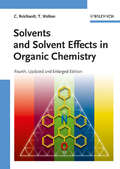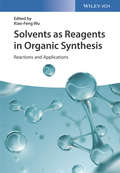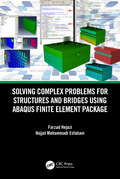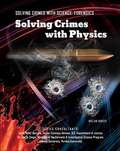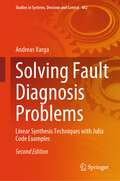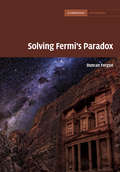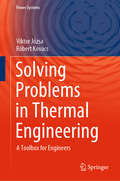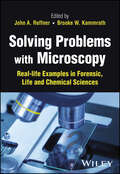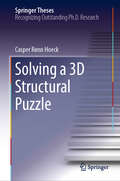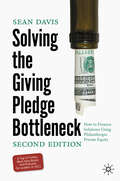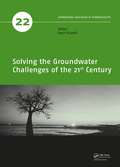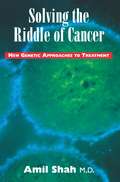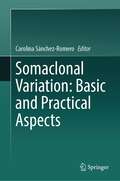- Table View
- List View
Solved and Unsolved Problems of Structural Chemistry
by Milan Randic Marjana Novic Dejan PlavsicSolved and Unsolved Problems of Structural Chemistry introduces new methods and approaches for solving problems related to molecular structure. It includes numerous subjects such as aromaticity-one of the central themes of chemistry-and topics from bioinformatics such as graphical and numerical characterization of DNA, proteins, and proteomes. It a
Solvent Effects in Chemistry
by Robert A. Stairs Erwin BuncelThis book introduces the concepts, theory and experimental knowledge concerning solvent effects on the rate and equilibrium of chemical reactions of all kinds. It begins with basic thermodynamics and kinetics, building on this foundation to demonstrate how a more detailed understanding of these effects may be used to aid in determination of reaction mechanisms, and to aid in planning syntheses. Consideration is given to theoretical calculations (quantum chemistry, molecular dynamics, etc.), to statistical methods (chemometrics), and to modern day concerns such as "green" chemistry, where utilization and disposal of chemical waste or by-products in an environmentally safe way is as important as achieving the desired end products by all chemists nowadays. The treatment progresses from elementary to advanced material in straightforward fashion. The more advanced topics are not developed in an overly rigorous way so that upper-level undergraduates, graduates, and newcomers to the field can grasp the concepts easily.
Solvent Engineering
by Yaocihuatl Medina-GonzalezThis book aims to present the concept of Solvent Engineering within a broad scope, ranging from mixtures of solvents to achieve the desired solvation properties, to stimuli-responsive solvents. It covers diverse aspects such as thermodynamics and transfer phenomena associated with solvent engineering, as well as applications found in recent literature, spanning materials across science, biochemistry, chemistry, and separation and purification processes, among others. Solvent engineering is proposed as an innovative strategy to address environmental concerns related to the use of volatile and toxic solvents. This book highlights efforts to develop engineered solvents that offer more environmentally acceptable alternatives as against those currently in use.
Solvent Extraction Principles and Practice, Revised and Expanded
by Michael Cox Gregory R. Choppin Jan Rydberg Claude MusikasA complete and up-to-date presentation of the fundamental theoretical principles and many applications of solvent extraction, this enhanced Solvent Extraction Principles and Practice, Second Edition includes new coverage of the recent developments in solvent extraction processes, the use of solvent extraction in analytical applications and waste re
Solvent Extraction and Liquid Membranes: Fundamentals and Applications in New Materials
by Manuel Aguilar José Luis CortinaThe applications of solvent extraction (SX) and liquid membranes (LM) span chemistry, metallurgy, hydrometallurgy, chemical/mineral processing, and waste treatment-making it difficult to find a single resource that encompasses fundamentals as well as advanced applications. Solvent Extraction and Liquid Membranes: Fundamentals and Applicat
Solvent Mixtures: Properties and Selective Solvation
by Yitzhak MarcusCompiling, comparing, and analyzing research from a wide range of abstracts, journal articles, and Web sites, this reference examines the properties, function, and behavior of binary, ternary, and multicomponent mixtures in the presence and absence of solutes. The author uniformly presents extensive data on the properties of solvent mixtures and describes their structures and interactions. He details the impact of preferential solvation on the environment, action, and components of chemical systems. The book highlights experimental approaches to determine when, and to what extent, preferential solvation has taken place and models for organic, ionic, macromolecular, and biochemical solutes.
Solvent Processes in Refining Technology (Petroleum Refining Technology Series)
by James G. SpeightThis book focuses on the various solvent processes that are used in crude oil refineries. It presents the differences between each type of process and discusses the types of feedstock that can be used for the processes. This accessible guide is written for managers, professionals, and technicians as well as graduate students transitioning into the refining industry. . Key Features: • Describes the various steps that are necessary for the solvent treatment of various feedstocks in crude oil refineries. Brings the reader up to date and adds more data. Provides an extensive glossary. Considers next-generation processes and developments.
Solvent-Free Methods in Nanocatalysis: From Catalyst Design to Applications
by Rafael Luque Manoj B. Gawande Esmail Doustkhah Anandarup GoswamiSolvent-Free Methods in Nanocatalysis Discover solvent-free approaches for the synthesis of nanocatalysts as well as various catalytic transformations in this unique one-stop resource Solvent-free methods have attracted wide attention in organic synthesis and catalysis as a promising approach towards “greener” and more sustainable chemical transformations. In this regard, nanocatalysis has seen particular growth in recent years. Solvent-Free Methods in Nanocatalysis gives an in-depth overview of nanocatalysts and their catalytic applications using solvent-free methods. After a brief introduction, it covers various synthetic techniques for the preparation of nanocatalysts and supports using solvent-free methods, e.g. ball-milling, microwave- and plasma-assisted methods. The book discusses in detail different catalyst classes, such as metal oxides, doped and functionalized nanocarbons, as well as nitride- and silica-based materials to help researchers to understand the efficiency and nature of these catalysts/supports based on their chemical structure. In the book readers will also find: A brief account of the history, challenges, and recent advances in the field Detailed discussion of advantages and disadvantages of solvent-free techniques for nanocatalyst preparation Treatment of important solvent- and catalyst-free organic transformations (i.e. oxidation, coupling and multicomponent reactions) A chapter on supported ionic liquids for solvent-free catalysis Written by leading researchers in the field, Solvent-Free Methods in Nanocatalysis is a useful reference for researchers and students working in organic synthesis, catalysis, and nanomaterials science.
Solvent-Induced Interactions and Forces in Protein Folding: Hydrophobic-Hydrophilic Phenomena (Physical Chemistry in Action)
by Arieh Ben-NaimThis monograph presents the molecular theory and necessary tools for the study of solvent-induced interactions and forces. After introducing the reader to the basic definitions of solvent-induced interactions, the author provides a brief analysis of the statistical thermodynamics. The book thoroughly overviews the connection of those interactions with thermodynamics and consequently focuses on specifically discussing the hydrophobic-hydrophilic interactions and forces. The importance of the implementation of hydrophilic interactions and forces in various biochemical processes is thoroughly analyzed, while evidence based on theory, experiments, and simulated calculations supporting that hydrophilic interactions and forces are far more important than the corresponding hydrophobic effects in many biochemical processes such as protein folding, self-assembly of proteins, molecular recognitions, are described in detail. This title is of great interest to students and researchers working in the fields of chemistry, physics, biochemistry, and molecular biology.
Solvent-Responsive Shape Memory Polymers for Biomedical Applications
by Abhijit Bandyopadhyay Sayan BasakThis book explains the intricacies of one-way shape memory polymers (SMPs), with a particular emphasis on solvent-responsive SMPs focusing on fundamental pathways and key principles crucial to the development of these materials. The subsequent section homes in on the specific realm of solvent-responsive SMPs, highlighting the potential advantages these polymers offer and critical evaluation of existing shortcomings and research gaps. It further explains how solvent-responsive SMPs aim to address challenges and advancements within the biomedical industry.Features: Delve into the latest developments and research findings on solvent-responsive shape memory polymers. Explore practical and real-world applications of solvent-responsive shape memory polymers in the biomedical domain. Provide an understanding of these polymers from molecular to macroscopic levels. Explore the underlying physics, chemistry, and thermodynamics that govern the mechanism of solvent-driven shape change in these polymers. Review innovations in the design of solvent-responsive shape memory polymers and their applications across a variety of industrial fields. Examine how solvent-responsive shape memory polymers can be integrated and applied across different scientific disciplines. This book is aimed at graduate students and researchers in polymer engineering, materials science, and bioengineering.
Solvents and Solvent Effects in Organic Chemistry
by Christian Reichardt Thomas WeltonNow in its 4th edition, this book remains the ultimate reference for all questions regarding solvents and solvent effects in organic chemistry. Retaining its proven concept, there is no other book which covers the subject in so much depth, the handbook is completely updated and contains 15% more content, including new chapters on "Solvents and Green chemistry", "Classification of Solvents by their Environmental Impact", and "Ionic Liquids". An essential part of every organic chemist's library.
Solvents as Reagents in Organic Synthesis: Reactions And Applications
by Xiao-Feng WuWritten by highly renowned and experienced authors, this is the only reference on the application of solvents as reagents. Clearly structured, the text describes various methods for the activation and reaction of these small molecules, highlighting the synthetic opportunities as well as process-oriented advantages. To this end, all relevant types of solvents are covered separately and emphasized with numerous synthetic examples, while taking care to explain applications so as to avoid undesired side reactions. The result is a unique resource for every synthetic chemist and reaction engineer in industry and academia working on the methodical optimization of synthetic transformations.
Solving Complex Problems for Structures and Bridges using ABAQUS Finite Element Package
by Farzad Hejazi Hojjat Mohammadi EsfahaniThis book aims to present specific complicated and puzzling challenges encountered for application of the Finite Element Method (FEM) in solving Structural Engineering problems by using ABAQUS software, which can fully utilize this method in complex simulation and analysis. Therefore, an attempt has been to demonstrate the all process for modeling and analysis of impenetrable problems through simplified step by step illustrations with presenting screenshots from software in each part and also showing graphs. Farzad Hejazi is the Associate Professor in the Department of Civil Engineering, Faculty of Engineering, University Putra Malaysia (UPM), and a Senior Visiting Academic at the University of Sheffield, UK. Hojjat Mohammadi Esfahani,an expert on Finite Element Simulation,has more than 10 years of experience in the teaching and training of Finite Element packages, such as ABAQUS.
Solving Crimes with Physics (Solving Crimes With Science: Forensics #12)
by William HunterMost people cringe when they hear the word physics. Physics is a very technical science that most people rely on every day, but do not really care to understand. Things work, and that is enough for most of us. Solving Crimes with Physics delves into the use of this challenging science to give readers a basic understanding of how the principles of physics can be used to solve crimes. From ballistics to bomb blasts, the knowledge of the theories of physics are powerful tools in the hands of a skilled forensic scientist.
Solving Fault Diagnosis Problems: Linear Synthesis Techniques with Julia Code Examples (Studies in Systems, Decision and Control #482)
by Andreas VargaThe goal of this new edition is the same as for the first edition ”to address the fault detection and isolation topics from a computational perspective“, by covering the same important aspects, namely, (1) providing a completely general theoretical treatment of fault and model detection problems for linear time-invariant systems; (2) presenting the best suited numerical approaches to solve the specific computational problems; (3) providing supporting software to solve the analysis and filter synthesis problems. In this second edition, the changes in the theoretical presentation are minor and all known errors and typos have been corrected. The major difference to the first edition is in the underlying computational support, which is now based on software developed in a relatively new language called Julia. The presentation of synthesis procedures and examples is similar to the first edition, but it is now interlaced with Julia codes which can be used to reproduce all computational examples and figures presented in the book. An Appendix has been added to cover some basic issues related to using Julia and the new FaultDetectionTools and DescriptorSystems packages.
Solving Fermi's Paradox (Cambridge Astrobiology #10)
by Duncan H. ForganThe search for extra-terrestrial intelligence (SETI) has for sixty years attempted to solve Fermi's paradox: if intelligent life is relatively common in the universe, where is everybody? Examining SETI through this lens, this volume summarises current thinking on the prevalence of intelligent life in the universe, and discusses sixty-six distinct solutions to the so-called paradox. It describes the methodology of SETI, and how many disciplines feed into the debate, from physics and biology, to philosophy and anthropology. The presented solutions are organised into three key groups: rare-Earth solutions, suggesting planetary habitability, life and intelligence are uncommon; catastrophist solutions, arguing civilisations do not survive long enough to make contact; and non-empirical solutions, those that take theoretical approaches, such as that our methodology is flawed. This comprehensive introduction to SETI concludes by looking at the future of the field and speculating on humanity's potential fate.
Solving Problems in Chemistry
by Gary K. HimesSolving Problems in Chemistry is designed for use in an introductory general chemistry course. This book, through the use of Example and practice problems, helps to develop problem-solving skills essential to the study of chemistry.
Solving Problems in Thermal Engineering: A Toolbox for Engineers (Power Systems)
by Viktor Józsa Róbert KovácsThis book provides general guidelines for solving thermal problems in the fields of engineering and natural sciences.Written for a wide audience, from beginner to senior engineers and physicists, it provides a comprehensive framework covering theory and practice and including numerous fundamental and real-world examples. Based on the thermodynamics of various material laws, it focuses on the mathematical structure of the continuum models and their experimental validation. In addition to several examples in renewable energy, it also presents thermal processes in space, and summarizes size-dependent, non-Fourier, and non-Fickian problems, which have increasing practical relevance in, e.g., the semiconductor industry. Lastly, the book discusses the key aspects of numerical methods, particularly highlighting the role of boundary conditions in the modeling process.The book provides readers with a comprehensive toolbox, addressing a wide variety of topics in thermal modeling, from constructing material laws to designing advanced power plants and engineering systems.
Solving Problems with Microscopy: Real-life Examples in Forensic, Life and Chemical Sciences
by Brooke W. Kammrath John A. ReffnerSolving Problems with Microscopy Comprehensive resource, based on real case examples, on the ability of the microscope for solving problems This book takes a “why to” rather than the common “how to” approach to demonstrate the capabilities of microscopy to solve problems. It provides entertaining and informative case examples and lessons regarding the unique value the microscope brings to problem solving by experienced scientists in various industries, including criminal and civil forensic science, manufacturing, environmental science, pharmaceutical science, cultural heritage, and biological sciences. Sample topics covered in this learning resource include: History of problem solving with microscopy Fortune favors the prepared mind The value of multiple associations The importance of context Knowing your limitations (i.e. knowing what you don’t know) Microscopists and other professional scientists who use microscopy can harness the information in this book to make better and more informed decisions by improving their problem-solving strategies and processes.
Solving a 3D Structural Puzzle
by Casper Rønn HoeckThis book explores how nuclear magnetic resonance (NMR) spectroscopy may be used for spatial structural elucidation of novel compounds from fungal and synthetic sources. Readers will discover the exciting world of NOE (nuclear Overhauser effect), RDC (residual dipolar coupling) and J-coupling constants, both short- and long range. With emphasis on obtaining structural knowledge from these NMR observables, focus is moved from solving a static 3D structure to solving the structural space inhabited by small organic molecules. The book outlines the development and implementation of two Heteronuclear Multiple Bond Correlation-type NMR experiments, and the 3D structural elucidation of multiple known and novel compounds. In addition, a new method of back-calculating RDCs (allowing for more flexible structures to be investigated), and the synthesis and evaluation of novel chiral alignment media for ab initio determination of absolute stereochemistry of small molecules using RDCs are also included. Challenges that 3D structural generation of small compounds face are also covered in this work.
Solving the Giving Pledge Bottleneck: How to Finance Solutions Using Philanthropic Private Equity
by Sean DavisThis book highlights the historic inflection point we are in, both in terms of philanthropy in general, and specifically in financing the solutions to our largest and most urgent social and environmental problems. It covers the two movements that have recently had a dramatic influence on capitalism. First, wealthy millennials have been pressuring their bankers to invest their family portfolios in companies with high social and environmental impact (ESG ratings), triggering a wave where the wealth management industry, and now all public companies, are significantly adapting to the increasing demand for good. Second, The Giving Pledge triggered another wave, changing what success and the accumulation of wealth means. It has even begun to redefine the goal of capitalism as more than 230 billionaires have pledged to give half or more of their wealth away. This book also focuses on the bottleneck problem that The Giving Pledge has created, as it is very hard to give hundreds of billions away with measurable impact to nonprofits lacking detailed long-term plans to scale. Nonprofits have never had the luxury of having all the resources to invest in the planning, management training and systems needed to rapidly expand. Thus taking in very large gifts is very difficult, and almost impossible to justify. Large philanthropy can always be used for traditional capital campaigns and to fund endowments, yet The Giving Pledge signers are often looking for large visible impact beyond these traditional avenues. The result is a bottleneck which has grown as more billionaires pledge their funds away while their wealth continues to skyrocket and giving rates stay very small. Finally, this book covers the emergence of large giving vehicles, modelled after the private equity industry. They have sophisticated third-party managers focused on deploying funds and supporting management teams. It also covers the scaling of nonprofits in a significant way (“Big Bets”) as well as investing large philanthropy through for-profits as Philanthropic Private Equity. This book is of interest specifically to nonprofit and foundation leaders, as well as wealth managers, estate attorneys and other philanthropic advisors. It is also of interest to investors and corporate CEOs as they begin to access these large pools for philanthropic capital to increase their impact. This book is focused on providing those with the ability to make large philanthropic investments a path to scale their impact and increase their fulfillment and that of their family. It provides a step-by-step guide of how these approaches, especially Philanthropic Private Equity, can actually solve the social and environmental challenges that have been seemingly hopeless. The second edition also presents a plan to use these concepts to create a path to solve the housing crisis in America.
Solving the Groundwater Challenges of the 21st Century (IAH - Selected Papers on Hydrogeology)
by Ryan VogwillGroundwater is integral to many human and environmental systems but there are significant challenges in dealing with the impact of anthropogenic activities on groundwater systems. These challenges need innovative solutions. This book contains a wide range of content, from a discussion of the Australian regulatory framework for unconventional hydroc
Solving the riddle of cancer: new genetic approaches to treatment
by Amil ShahAs recently as the middle of this century, cancer was still a mysterious disease. It seemed to strike with reckless abandon, and once it had gripped its victim, doctors could do little more than relieve the pain, steady the pulse and ease the breathing. It is all too easy now to reflect on this sad state of affairs without realizing that cell biology itself was also a rudimentary science. In the past few years, a vastly different view of cancer has emerged. The highly sophisticated tools of genetic engineering have allowed biologists to look deep into the inner provinces of the cell, and what they have learned is taking biology and medicine in a completely new direction. Only a decade ago, the concept of gene therapy was unknown to most scientists and clinicians. The problems of such therapy were thought to be insurmountable and not given serious consideration. The striking advances in our understanding of cancer in the recent past have, however, changed all of this. It is astonishing how much progress has been made in such a short time; biology has moved from strength to strength, and what seemed daunting not so long ago can now be confidently tackled. The road to this new understanding of how a cell works and what makes it malignant has not always been easy, but the great achievements are undeniable. With today’s cell biology comes the promise of a totally new kind of treatment.
Somaclonal Variation: Basic and Practical Aspects
by Carolina Sánchez-RomeroThis book is fundamental for plant biotechnologists at this moment, due to the extensive use of in vitro culture. Although some books about somaclonal variation were published some years ago, the circumstances in this field have undergone a great change in the last years. Much progress has been achieved in plant in vitro culture: new technologies have been developed, previously used protocols have been modified with regard to optimization, and in vitro techniques have been applied to new species. Besides, tools for somaclonal variation analysis have also changed in the last years. The techniques and instruments have substantially improved, with the development of new molecular markers and the increased precision and sensitivity of some instruments. Furthermore, novel knowledge about the basic mechanisms underlying somaclonal variation has been obtained recently, which can be very useful for explaining the variability found in different experimental systems.Therefore, it is evident that information about basic and practical aspects of somaclonal variation requires updating and the proposed book is a very good means for this purpose.
